
Content Partner
Grades 6-8, 9-12
Happy EconEdMonth! Celebrate economics all month long by visiting EconEdMonth.org

Don't have an account yet? Sign up for free
Don't have an account yet? Sign up for free
Students will be able to:

In this economics lesson, students will use a budget plan to make spending decisions.
Warm-Up
Tell students that today’s lesson is about making choices and how a spending plan can help them have the things they want and need. Remind students that life sometimes seems unfair because they cannot have everything they want or need; every time we make a choice, we have to give up something. Explain that they will see a short video illustrating this concept, commonly called opportunity cost. Opportunity costs exists because life is full of choices. Show the video Opportunity Cost. Review the video asking the following questions:
Modeling
Tell students that scarcity and opportunity cost are important concepts to understand when making decisions about spending and saving, and today’s lesson will help them apply those concepts to their personal lives. Distribute copies of What Do You Want. Tell students they should make a list of things they want to have during the next month and list them on the sheet. They should then prioritize their list, with one being the most important thing to them. After prioritizing, students should estimate or research the price of each item listed by visiting store web sites. When they have completed that task, tell students they only have $200 to spend on their list of items. Remind students they may choose to save some of their money for a future want or need instead of spending all of it. The amount they want to save should also be included in their $200. Once students have completed their lists, explain that they have created a spending plan or a budget. Explain that budgets are generally established for a year, and based on a month of typical income and spending patterns. The $200 in this activity shows the maximum amount of money students have to spend (representing their income) and the items listed are what they can purchase. Tell students that a real budget should always include some amount of savings to help purchase things they will need in the future. Ask students to circle the items they eliminated from their budgets to meet the $200 limit and put an X next to their next best choice (the next item on their list of priorities). Remind them that item is their opportunity cost. Ask the following questions to debrief the activity: Why did they choose to eliminate certain items? How did it make them feel to realize they could not have everything on their list? Was it hard to give up the other items listed? Would they have made different choices if they had known the limit was only $200? What is the value of setting aside some of their money for savings?
Group Activity
Tell students that sometimes it is necessary to exceed their budget when making important choices. When exceeding their budget, they can either use the money they have saved or borrow the money the additional amount needed. Remind them that borrowing money means they are making a commitment to future payments, with interest. It also means they will pay more than the stated price for the product. Put students into small groups, explaining they will work together to help three people make budget decisions. Distribute copies of the group activity What is the Opportunity Cost?. Have groups review each situation to determine if it is a good idea for that person to exceed their budget. Tell students to discuss each situation within their groups, write down their decision, and write a brief explanation for that decision. Also, have groups identify the opportunity cost in each situation. Once completed, ask groups to share their decisions with the class.
(Answers: Situation 1. Absolutely!!! There is a growing need for officials to work games. Once Bill gets known in officiating circles, he will have opportunities to make thousands of dollars in a basketball season. Even if Bill borrows the money to attend the camp and needs to buy some basic equipment, he will come out ahead in the long run. The opportunity costs is the cost of the camp which is $350.00. Situation 2. She should take the station wagon because she can’t afford the Mustang convertible. She also is making assumptions about her improved social life which may or may not be true. The opportunity cost will possibly be less popularity and getting fewer dates. Situation 3. Yes!!! Assuming he is a good teacher, he is very likely to get a job with a high starting salary. Most likely, he will earn significantly more money over his teaching career if he attends the university with a nationally known school of education. While he will be behind in the beginning of his career, he should make up this difference over the length of a long teaching career. Claudio could also apply for scholarships or work-study jobs to help offset some of his debt while attending school. The opportunity cost is being in debt and not being able to do some things for a while since he in debt.) Conclude the activity by telling students that making good financial decisions when they are younger is an important step toward financial success later in life. Controlling expenses and starting a savings plan can build a solid financial base, avoid getting into debt and overspending on unnecessary purchases.
Individual Activity
Have students write a one-page essay explaining the difficulties or challenges they faced when making choices about their priorities and their $200 budget. If they didn’t have difficulties, their essay could focus on why it was easy for them to make those choices.
Have students play the Kahoot Quiz associated with the Opportunity Cost video. Review their answers to ensure they understand the concepts presented in this lesson.
Activity 1
Students will make a budget based on their actual monthly income. This income may come from jobs they do, gifts they receive, and any allowances given by their family. The budget must be a balanced budget. If they do not have any allowances or monetary gifts, give them a budget of $10 a day. Be sure they include basic expenses, such as movies, school lunches, snacks, etc. Also, require them to put a minimum of ten percent of their income into savings.
Activity 2
Put students into small groups. Have each group create a short play or skit to perform for the class focused on the need for budgeting, how to develop a balanced budget, and how to follow their spending plan. (Option: Have them create posters to hang in the class, library, or hallway showing the importance of budgeting.)

Content Partner
Grades 6-8, 9-12

Grades 9-12


Grades K-2, 3-5
